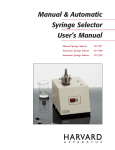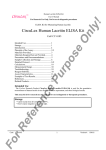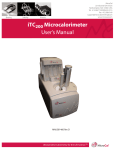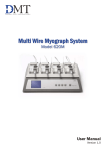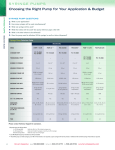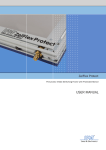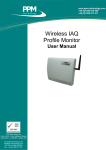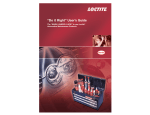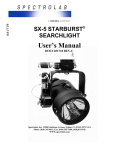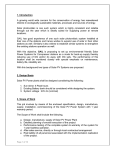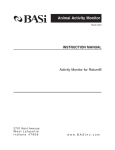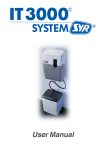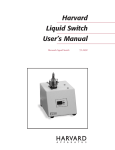Download Manual & Automatic Syringe Selector User`s Manual
Transcript
Manual & Automatic Syringe Selector User’s Manual Manual Syringe Selector Automatic Syringe Selector Automatic Syringe Selector MA1-59-7357 MA1-59-7358 MA1-59-7359 Publication 5401-002-REV- A WEEE/RoHS Compliance Statement EU Directives WEEE and RoHS To Our Valued Customers: We are committed to being a good corporate citizen. As part of that commitment, we strive to maintain an environmentally conscious manufacturing operation. The European Union (EU) has enacted two Directives, the first on product recycling (Waste Electrical and Electronic Equipment, WEEE) and the second limiting the use of certain substances (Restriction on the use of Hazardous Substances, RoHS). Over time, these Directives will be implemented in the national laws of each EU Member State. Once the final national regulations have been put into place, recycling will be offered for our products which are within the scope of the WEEE Directive. Products falling under the scope of the WEEE Directive available for sale after August 13, 2005 will be identified with a “wheelie bin” symbol. Two Categories of products covered by the WEEE Directive are currently exempt from the RoHS Directive – Category 8, medical devices (with the exception of implanted or infected products) and Category 9, monitoring and control instruments. Most of our products fall into either Category 8 or 9 and are currently exempt from the RoHS Directive. We will continue to monitor the application of the RoHS Directive to its products and will comply with any changes as they apply. • Do Not Dispose Product with Municipal Waste • Special Collection/Disposal Required Table of Contents Harvard Apparatus Syringe Selector 1 SUBJECT PAGE NO. General Information - Warranty and Repairs ......................2 Specifications..........................................................................3 Introduction ............................................................................4 Theory of Operation ..............................................................4 Connections ............................................................................5 Fitting Instructions: Cutting and Polishing ................................................6 Cleaning ....................................................................7 Fitting Assembly ........................................................7 Calculating Dead Volume: Controlling the Syringe Selector with a Computer ......8 General Information 2 Harvard Apparatus Syringe Selector Serial Numbers All inquires concerning our product should refer to the serial number of the unit. Serial numbers are located on the rear of the chassis. Calibrations All electrical apparatus is calibrated at rated voltage and frequency.While the flow will stay calibrated, the peak will vary. W a rr a n t y Harvard Apparatus warranties this instrument for a period of two years from date of purchase.At its option, Harvard Apparatus will repair or replace the unit if it is found to be defective as to workmanship or material. This warranty does not extend to damage resulting from misuse, neglect or abuse, normal wear and tear, or accident. This warranty extends only to the original customer purchaser. IN NO EVENT SHALL HARVARD APPARATUS BE LIABLE FOR INCIDENTAL OR CONSEQUENTIAL DAMAGES. Some states do not allow exclusion or limitation of incidental or consequential damages so the above limitation or exclusion may not apply to you. THERE ARE NO IMPLIED WARRANTIES OF MERCHANTABILITY, OR FITNESS FOR A PARTICULAR USE, OR OF ANY OTHER NATURE. Some states do not allow this limitation on an implied warranty, so the above limitation may not apply to you. If a defect arises within the two-year warranty period, promptly contact Harvard Apparatus, Inc. 84 October Hill Road, Building 7, Holliston, Massachusetts 01746-1371 using our toll free number 1-800-272-2775. Goods will not be accepted for return unless an RMA (returned materials authorization) number has been issued by our customer service department. The customer is responsible for shipping charges. Please allow a reasonable period of time for completion of repairs, replacement and return. If the unit is replaced, the replacement unit is covered only for the remainder of the original warranty period dating from the purchase of the original device. This warranty gives you specific rights, and you may also have other rights which vary from state to state. R e p a i r F a c i l i t i e s a n d P a rt s Harvard Apparatus stocks replacement and repair parts.When ordering, please describe parts as completely as possible, preferably using our part numbers. If practical, enclose a sample or drawing.We offer a complete reconditioning service. CAUTION This pump is not registered with the FDA and is not for clinical use on human patients. Specifications Harvard Apparatus Syringe Selector 3 Specifications Switching Capacity 4 syringes Port Diameter 0.020 in Dead Volume: Selected Side Waste Side at 10 µ l at 30 µ l Connection for the Port Valco type ZDV connectors Introduction Harvard Apparatus Syringe Selector 4 Harvard Syringe Selectors are designed to switch the perfusion medium from one of up to four syringes. The selected stream flows through a port connected to the animal while all non-selected syringes flow to a common waste port. Up to 4 syringes may be connected to the Syringe Selector. If less than 4 ports are required, the unused ports may be plugged. The Automatic Syringe Selector is available in 110 VAC and 220 VAC models. Please check to insure that both power supply and the model match. The Automatic Syringe Selector is supplied with a computer interface, external control (remote control) and with a manual event control capacity. Using the computer interface, it can be used in a fully automated manner. Theory of Operation Manual Use of the Automatic Syringe Selector 1. Plug the Syringe Selector into an appropriate power outlet and turn the power switch on. The LED indicator light on the front panel will come on indicating the position of the valve. 2. Press the control toggle switch momentarily toward HOME. If the valve is not in position 1, it will realign to the position 1. If it is already aligned, it will not move. As the valve moves towards HOME (position 1), it may sequence through each position, allowing the possibility that sample may flow briefly through each syringe into the per-fusion outlet. Care must be taken to prevent possible contamination.The best way to avoid this is to always perform operation #2 before before making any connections. 3. Make connections as required (See Connections Section). 4. To switch from one perfusion medium to the next, move the toggle switch momentarily toward STEP and the valve will advance from position 1 to position 2. Pressing this switch again will advance it one more step. Port 1 is located at the 12 ’O Clock position. The valve rotates counter clockwise. Therefore the 9 ’O Clock position is the port 2 where syringe 2 must be connected. Ports 1, 2, 3 and 4 are 90° apart. The drain port is nearest to the actuator handle/motor.The outlet is nearest to the spring. Connections Harvard Apparatus Syringe Selector 5 In order to insure flexibility, the Syringe Selector is designed with ports which accommodate the standard 1/16 inch tubing. Any 0.300 inch or longer Valco type nut and ferrule assembly can be used to attach 1/16 inch tubing in the port (see Fitting Instructions). This offers endless connection possibilities using various off-the-shelf hardware and flexibility in connection materials. The following are some suggestions how the Syringe Selector may be connected in a microdialysis system. U s i n g t h e S t a n d a rd 2 3 G a u g e C o n n e c t o r s Connections can be made using the supplied 1/16 inch, 23 gauge Reducing Adapters. The 1/16 inch side is inserted in the port with the ferrule and the nut, and using a wrench the ferrule is permanently clamped to the 1/16 inch side. (A finger tight nut can be used as an alternative to the supplied steel nut and ferrule assembly.) This makes a removable connector adapter. Otherwise, the other end of the adapter (23 gauge side) can be connected to the CMA blue connectors to accommodate the Teflon connecting tubes. When using the Harvard Fused Silica Tubes, a 23 gauge adapter can be used to make a connection. U s i n g t h e P E E K o r S t a i n l e s s S t e e l 1 / 1 6 i n c h Tu b i n g A 1/16 inch PEEK or Stainless Steel tube may be used for connection. The smallest inside diameter available of these tubes is generally 0.005 inch or 125 µm. PEEK tubing connections offer chemically inert contact to the passing fluid. Further reduction in the inner diameter of these tubes can be achieved by using fused silica connections. A 1/16 inch Fused Silica Connector Adaptor can be used to connect to a fused silica connecting tube. O t h e r A l t e rn i t i v e s Fused Silica Connecting Tubes can be connected directly to the port using a Valco fused silica connection adapter. However, if the switch flow path is not rinsed properly after each used, the port may be permanently damaged due to a clogged or broken fused silica adapter in the port. The Valco-type Zero Dead Volume Fitting is comprised of four parts: a female zero volume fitting detail, a male nut, a ferrule, and a length of tubing (see Figure 1). Since the leak-tightness and integrity of the fitting is dependent upon tubing preparation and proper assembly, this section addresses those two topics. Fitting Instructions Harvard Apparatus Syringe Selector 6 The Valco-type Zero Dead Volume Fitting is comprised of four parts: a female zero volume fitting detail, a male nut, a ferrule, and a length of tubing (see Figure 1). Since the leak-tightness and integrity of the fitting is dependent upon tubing preparation and proper assembly, this section addresses those two topics. Tube Nut Ferrule Fitting Detail Pilot Cutting and Polishing Since the tubing is an integral part of the fitting, it must be properly prepared if the entire fitting is to function as designed. To insure trouble-free service,Valco suggests using their electrolytically pre-cut and polished tubing in stainless steel,electroformed nickel, Nickel 200, Hastalloy C, or other materials. If other tubing is to be used, make certain that all tubing ends are cut square with the tube axis, and that both the ID and the OD are thoroughly deburred. Will Leak Will Not Leak Next, inspect the end of the tubing where the ferrule will seat for scratches along its length (Figure 2). Visible scratches along the tubing where the ferrule will seat are not acceptable, but those behind the front edge of the ferrule will not interfere with the integrity or the fitting. Minor scratches can often be eliminated by folding a small piece of fine emery cloth or wet-or-dry sandpaper (200 to 400 grit) around the end of the tubing and rolling the tubing between two fingers. This leaves concentric axial lines in the area where the ferrule seats, which, while not ideal, are less likely to cause a leak than longitudinal scratches. NOTE: Electropolishing is generally not successful as a repair for bad tubing, as it often simply rounds off the edges of a scratch without removing it. Fitting Instructions 7 Harvard Apparatus Syringe Selector Cleaning After it has been polished, the tubing must be cleaned to remove residual metal shavings and grit from the sandpaper. This is best accomplished by using a syringe or pipette to force a solvent such as methyl or isopropyl alcohol or acetone through the tubing and then drying it with clean, dry compressed air or carrier gas. Fitting Assembly 1. Slide the nut and ferrule onto the tubing in the order shown in Figure 1. 2. Insert the assembly into the fitting detail, screwing the nut in two or three times by hand. 3. Push the tubing all the way forward into the detail so that it seats firmly. This is essential for a proper zero dead volume connection. 4. Manually turn the nut into the detail until it is finger tight. 5. Using the appropriate open end wrench, turn the nut 1/4 turn (90°) past the point where the ferrule first starts to grab the tubing. Fittings larger than 1/8 inch will require more than 1/4 turn (as much as 120°). The amount of force required can vary considerably due to the friction between the nut and the threads and the composition and wall thickness of the tubing being used. Because of these variables a torque specification is unreliable. 6. Remove the fitting and inspect it. When made up properly, the ferrule may be free to spin axially on the tubing, but should have no lateral movement along the tubing. If the ferrule moves laterally, reinstall the fitting into the detail and tighten it another 1/8 turn past finger tight. 7. Remove, reinspect, and repeat if necessary. Once made up correctly, this Zero Dead Volume detail can be remade many times without loss of integrity. Approximately 1/8 tun (45°) past finger tight is adequate for most fittings. If additional torque is required, increase in increments of 1/16 turn. The switching time (time required for motor to move one step forward) is approximately 1 second. No matter what type of connecting tubes are used, it is advisable that the dead volume should be kept to a minimum. Minimizing the dead volume, especially at all the joints would reduce the time it takes for alternative perfusion medium to reach the probe tip. Calculating Dead Volume Harvard Apparatus Syringe Selector 8 The dead volume can be calculated by adding volumes of all the tubes in a flow path. A syringe selector has a dead volume of approximately 10 µl. Therefore it should be ensured that all the reducing adapters are fully inserted. Precautions should be taken to insure proper flow switching that the flow should equilibriate before switching. Usually a 5 to 10 minute wait is sufficient after connecting the new syringe for flow equilibration. A higher than expected time may be observed for fluid to reach the animal after switching the syringe if there is a pressure buildup in the system. After the initial setup this can be tested by using carbachol in the switched perfusion medium which induces a behavioral seizure as soon as it reaches the probe. If the time interval for the fluid is more than expected, pressurizing the waste port (connecting an equal length of the same connecting tube as the selected outlet side on the waste port) would eliminate this problem. C o n t ro l l i n g t h e S y r i n g e S e l e c t o r w i t h a C o m p u t e r The easiest way of achieving a completely automatic operation is by using a Serial Interfacing Device (optional), which allows control of up to two fluid selectors and up to four Valco type electrically actuated HPLC valves using a PC. However, there are alternatives to the PC control of the device. The actuator part can be operated with many kind of relays, open collector transistors, BCD or logic level signal outputs or an RS-232 connector. If you wish to control the Syringe Selector with other means than manual or the serial interfacing device, please request the technical notes on electronic circuitry of the switch.










